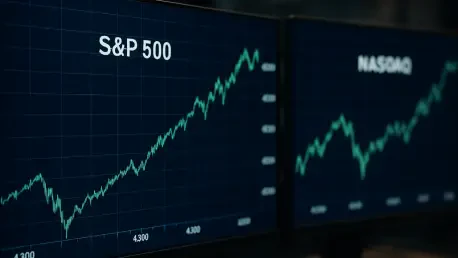On a tense day for Wall Street, the U.S. stock market experienced a notable downturn as major indices—the Dow Jones Industrial Average, S&P 500, and Nasdaq Composite—all recorded declines on August 11. This slump, driven by a mix of geopolitical trade uncertainties and the looming release of pivotal inflation data, has left investors navigating a landscape fraught with ambiguity. The Dow shed nearly 0.5%, closing at 43,975.09 after losing about 200.52 points, while the S&P 500 edged down by 0.2%, and the Nasdaq slipped 0.3%. These drops reflect broader concerns about how ongoing trade policies and upcoming economic indicators might shape the financial outlook. Beyond the raw numbers, there’s an undercurrent of apprehension gripping the market, as traders brace for potential shifts in monetary policy that could either stabilize or further unsettle equities. The day’s performance serves as a stark reminder of how interconnected global policies and domestic economic data have become, influencing sentiment and decision-making across the board. As Wall Street grapples with these dual pressures, the immediate future remains uncertain, with all eyes turning to critical reports and governmental decisions that could sway market direction in the coming days.
Trade Policy Impacts Weigh on Investor Sentiment
The latest developments in U.S. trade policy have introduced a significant layer of uncertainty into the market, contributing to the declines seen across major indices. President Donald Trump’s announcement of a 90-day extension on harsher tariffs against China, pushing the deadline to November 9, was intended to support ongoing negotiations for a more robust trade agreement. Reported by reputable sources such as CNBC and The Wall Street Journal, this decision has sparked a range of reactions among investors. While the extension offers a temporary reprieve from immediate economic conflict, it also prolongs the suspense surrounding a final resolution. Despite claims from the administration that tariffs exert a substantial positive influence on the stock market, the day’s downturn suggests that many traders remain skeptical about the short-term benefits. This disconnect between policy rhetoric and market reaction underscores the fragility of investor confidence in the face of unpredictable trade outcomes, leaving many to question whether this delay will ultimately yield a favorable deal or merely postpone inevitable tensions.
Further complicating the trade landscape are sector-specific policies that reveal the nuanced impacts of these decisions. Exemptions, such as the one for gold, alongside unconventional revenue-sharing agreements with technology giants like Nvidia and AMD, demonstrate how targeted measures can ripple through different industries. For instance, the agreement requiring certain tech firms to share a portion of their China sales revenue with the U.S. government in exchange for export licenses has raised eyebrows and contributed to slight declines in their stock prices. These tailored approaches to trade policy add layers of complexity, as investors must assess not only broad economic implications but also how individual sectors and companies might fare under such arrangements. The resulting uncertainty has fueled a cautious approach among market participants, who are keenly aware that each policy tweak could have far-reaching consequences for profitability and growth prospects across diverse segments of the economy.
Anticipation Builds for Crucial Inflation Report
As the market digests trade policy developments, attention is increasingly focused on the upcoming Consumer Price Index (CPI) report for July, scheduled for release on August 12. Economists are projecting a modest increase in annual inflation to 2.8% from 2.7% in the previous month, with core inflation expected to tick up to 3.0% from 2.9%. These figures carry significant weight, as they could provide insight into how recent trade tariffs are influencing consumer prices across various sectors. A higher-than-expected inflation reading might confirm fears that tariffs are driving up costs, potentially putting pressure on the Federal Reserve to adopt a more stringent monetary stance in September. Investors are closely monitoring these projections, recognizing that the data could either reinforce concerns about persistent price pressures or offer a glimmer of hope for stabilization, thereby shaping expectations for interest rate adjustments and overall economic policy.
The stakes surrounding this inflation report are heightened by its potential to influence broader market sentiment in an already volatile environment. If the data indicates that tariff-induced cost increases are seeping into everyday expenses, it could dampen consumer spending and business investment, further weighing on stock valuations. Conversely, a softer-than-anticipated report might bolster arguments for a more accommodative Federal Reserve policy, providing some relief to equities. The uncertainty surrounding these outcomes has fostered a cautious atmosphere on Wall Street, where traders are balancing the risks of sustained inflation against the possibility of supportive rate cuts. This pivotal moment underscores the interconnectedness of economic indicators and policy decisions, as the forthcoming CPI data stands to either exacerbate existing market jitters or pave the way for a more confident investment outlook in the near term.
Tech Sector Navigates a Complex Landscape
Within the technology sector, the impact of recent trade policies and broader economic concerns has produced a mixed bag of outcomes for major players. Nvidia and AMD, two prominent chipmakers, experienced slight declines in their stock prices following an agreement to share 15% of their China sales revenue with the U.S. government as a condition for export licenses. This unprecedented arrangement has sparked debate over its legal ramifications and strategic implications, with some legal experts suggesting that challenges to the deal may arise due to its unorthodox nature. The uncertainty surrounding this policy has cast a shadow over investor confidence in these companies, despite their otherwise strong market positions. As technology firms find themselves increasingly entangled in geopolitical dynamics, the market remains on edge, wary of how such policies might alter competitive landscapes and long-term growth trajectories.
In contrast, other tech companies have managed to buck the downward trend, showcasing resilience amid the broader market slump. Tesla saw a 3% surge in its stock price after submitting an application for a U.K. electricity supply license, signaling potential expansion into new markets. Similarly, Intel gained over 4% following reports of productive discussions between its CEO and President Trump, while Micron rose 4% on the back of an optimistic Q4 guidance. These positive movements highlight the varied impacts of macroeconomic and policy factors across the tech sector, where individual company strategies and external developments can lead to starkly different outcomes. The divergence in performance among tech stocks illustrates the challenges investors face in navigating a sector that is both a driver of innovation and a battleground for geopolitical and economic forces, keeping market watchers attentive to every new development.
Cryptocurrency Rally Defies Market Caution
While traditional equities faced headwinds, the cryptocurrency market painted a starkly different picture with a remarkable rally that captured significant attention. Bitcoin surged to a peak of $122,000 before settling at $120,000, while Ethereum revisited price levels not seen in several years. This impressive upswing reflects a risk-on sentiment among a subset of investors, fueled by substantial inflows into exchange-traded funds (ETFs) and growing corporate adoption of digital currencies. The stark contrast between the crypto boom and the caution gripping the broader stock market highlights a divergence in investor appetites, with some seeking high-risk, high-reward opportunities amid an uncertain economic backdrop. This rally suggests that alternative assets are increasingly viewed as viable options during periods of traditional market unease.
The cryptocurrency surge is also underpinned by expectations of potential shifts in monetary policy that could favor riskier assets. Speculation about a looser stance from the Federal Reserve, possibly influenced by new leadership considerations under President Trump, has added to the enthusiasm driving digital currency valuations. This optimism stands in opposition to the more restrained mood in equity markets, where concerns about inflation and trade tensions dominate. As cryptocurrencies continue to gain traction, their performance serves as a reminder of the evolving nature of investment landscapes, where traditional and emerging asset classes can react differently to the same set of economic signals. The sustained strength in this sector may prompt further analysis of how monetary policy expectations shape diverse market segments in the coming months.
Commodity Markets React to Policy Shifts
Commodity markets, particularly gold, have not been immune to the volatility spurred by ambiguous policy communications. Gold futures experienced a sharp decline of over 2%, settling at $3,404 per ounce, after President Trump clarified that the precious metal would be exempt from tariffs. This drop reversed earlier gains that had been driven by confusion over potential levies on Swiss gold bars, demonstrating the sensitivity of commodities to governmental statements. Traders, as reported by Bloomberg, reacted swiftly to the updated policy stance, illustrating how critical clear and consistent communication is for maintaining stability in these markets. The rapid price adjustment in gold underscores the broader market’s reliance on predictable policy frameworks to guide investment decisions.
The volatility in gold prices also reflects a larger pattern of uncertainty that permeates financial markets during periods of significant policy flux. When initial reports suggested that tariffs might apply to certain gold imports, prices spiked as investors sought safe-haven assets amid trade tensions. However, the subsequent clarification led to a sell-off, as the perceived need for such a hedge diminished. This whipsaw effect highlights the challenges faced by commodity traders who must navigate not only economic fundamentals but also the often unpredictable nature of policy announcements. As trade negotiations and economic data releases continue to unfold, the commodity sector remains a key area to watch for insights into how policy ambiguity can influence broader market dynamics and investor behavior over time.
Corporate Performances Highlight Market Disparities
Individual company performances on August 11 provided a microcosm of the broader market’s struggles and successes, reflecting the uneven impact of economic conditions. C3.ai faced a steep decline, with its stock plummeting 23% after reporting a revenue shortfall attributed to internal reorganization and health issues affecting its CEO. This significant drop signals underlying vulnerabilities that can be exacerbated by a challenging economic environment, drawing attention to how internal factors can compound external pressures. The sharp fall in share price serves as a cautionary tale for investors, emphasizing the importance of robust corporate governance and adaptability in times of market uncertainty, particularly for firms in competitive sectors like artificial intelligence.
On the other hand, some companies managed to shine despite the day’s overall downturn, showcasing resilience in specific industries. AMC Entertainment saw an 8% rise in its stock value, buoyed by strong second-quarter attendance figures driven by popular blockbuster films. Similarly, Paramount marked a strategic victory with a $7.7 billion broadcast deal for UFC, highlighting the entertainment sector’s potential to thrive amid broader market challenges. These gains stand in contrast to struggles elsewhere, such as Monday.com, which saw its shares tumble 20% after disappointing earnings results. The disparities in corporate outcomes underscore the varied ways in which macroeconomic trends, policy shifts, and company-specific strategies intersect, offering investors a complex tapestry of risks and opportunities to navigate in the current financial climate.
Reflecting on a Day of Market Turbulence
Looking back on the events of August 11, the declines in the Dow, S&P 500, and Nasdaq painted a picture of a market wrestling with multifaceted uncertainties. The interplay of trade policy developments, particularly the tariff extension with China, and the anticipation surrounding the July CPI report created a backdrop of caution that shaped investor behavior throughout the trading session. Mixed outcomes in the tech and entertainment sectors, alongside a striking cryptocurrency rally, added layers of complexity to the day’s narrative, revealing the diverse responses to overarching economic pressures.
Moving forward, market participants would be wise to closely monitor the inflation data release and subsequent Federal Reserve actions, as these will likely set the tone for near-term market trajectories. Keeping an eye on evolving trade negotiations and their sector-specific implications could also provide critical insights for strategic positioning. As policy clarity remains elusive in some areas, such as commodity tariffs and tech revenue agreements, adopting a flexible investment approach may help mitigate risks. The turbulence witnessed on this day serves as a prompt to reassess exposure to volatile sectors while seeking opportunities in areas showing resilience, ensuring a balanced perspective in navigating the uncertain financial landscape ahead.









